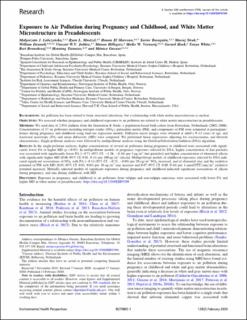Exposure to Air Pollution during Pregnancy and Childhood, and White Matter Microstructure in Preadolescents
Lubczyńska, Małgorzata J.; Muetzel, Ryan L.; El Marroun, Hanan; Basagaña, Xavier; Strak, Maciej; Denault, William Robert Paul; Jaddoe, Vincent W.V.; Hillegers, Manon; Vernooij, Meike W.; Hoek, Gerard; White, Tonya; Brunekreef, Bert; Tiemeier, Henning; Guxens, Mònica
Journal article, Peer reviewed
Published version

Åpne
Permanent lenke
https://hdl.handle.net/11250/2738416Utgivelsesdato
2020Metadata
Vis full innførselSamlinger
Originalversjon
Environmental Health Perspectives. 2020, 128, 2, 027005-1 - 027005-11 10.1289/EHP4709Sammendrag
Background:
Air pollution has been related to brain structural alterations, but a relationship with white matter microstructure is unclear.
Objectives:
We assessed whether pregnancy and childhood exposures to air pollution are related to white matter microstructure in preadolescents.
Methods:
We used data of 2,954 children from the Generation R Study, a population-based birth cohort from Rotterdam, Netherlands (2002–2006). Concentrations of 17 air pollutants including nitrogen oxides (NOX), particulate matter (PM), and components of PM were estimated at participants’ homes during pregnancy and childhood using land-use regression models. Diffusion tensor images were obtained at child’s 9–12 years of age, and fractional anisotropy (FA) and mean diffusivity (MD) were computed. We performed linear regressions adjusting for socioeconomic and lifestyle characteristics. Single-pollutant analyses were followed by multipollutant analyses using the Deletion/Substitution/Addition (DSA) algorithm.
Results:
In the single-pollutant analyses, higher concentrations of several air pollutants during pregnancy or childhood were associated with significantly lower FA or higher MD (p<0.05). In multipollutant models of pregnancy exposures selected by DSA, higher concentration of fine particles was associated with significantly lower FA [−0.71 (95% CI: −1.26, −0.16) per 5 μg/m3 fine particles] and higher concentration of elemental silicon with significantly higher MD [0.06 (95% CI: 0.01, 0.11) per 100 ng/m3 silicon]. Multipollutant models of childhood exposures selected by DSA indicated significant associations of NOX with FA [−0.14 (95% CI: −0.23, −0.04) per 20-μg/m3NOX increase], and of elemental zinc and the oxidative potential of PM with MD [0.03 (95% CI: 0.01, 0.04) per 10-ng/m3 zinc increase and 0.07 (95% CI: 0.00, 0.44) per 1-nmol DTT/min/m3 oxidative potential increase]. Mutually adjusted models of significant exposures during pregnancy and childhood indicated significant associations of silicon during pregnancy, and zinc during childhood, with MD.
Discussion:
Exposure in pregnancy and childhood to air pollutants from tailpipe and non-tailpipe emissions were associated with lower FA and higher MD in white matter of preadolescents.